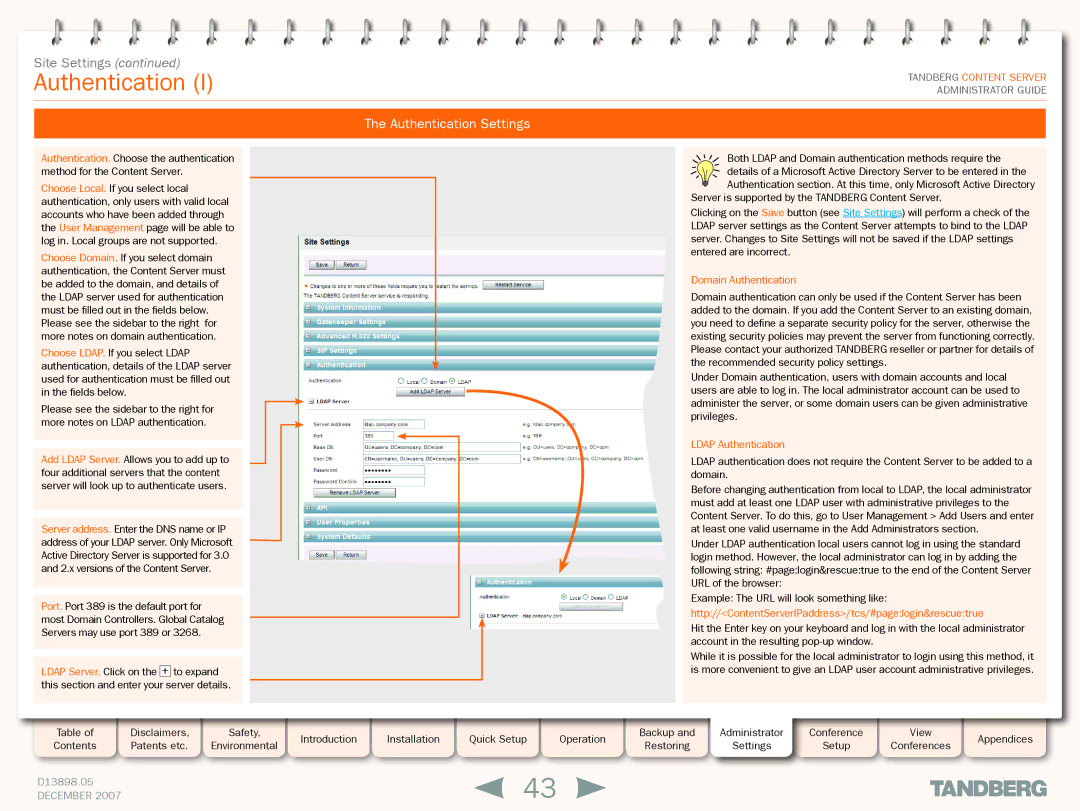
Site Settings (continued)
Authentication (I)
The Authentication Settings
TANDBERG CONTENT SERVER ADMINISTRATOR GUIDE
Authentication. Choose the authentication method for the Content Server.
Choose Local. If you select local authentication, only users with valid local accounts who have been added through the User Management page will be able to log in. Local groups are not supported.
Choose Domain. If you select domain authentication, the Content Server must be added to the domain, and details of the LDAP server used for authentication must be filled out in the fields below. Please see the sidebar to the right for more notes on domain authentication.
Choose LDAP. If you select LDAP authentication, details of the LDAP server used for authentication must be filled out in the fields below.
Please see the sidebar to the right for more notes on LDAP authentication.
Add LDAP Server. Allows you to add up to four additional servers that the content server will look up to authenticate users.
Server address. Enter the DNS name or IP address of your LDAP server. Only Microsoft Active Directory Server is supported for 3.0 and 2.x versions of the Content Server.
Port. Port 389 is the default port for most Domain Controllers. Global Catalog Servers may use port 389 or 3268.
LDAP Server. Click on the + to expand this section and enter your server details.
Both LDAP and Domain authentication methods require the
details of a Microsoft Active Directory Server to be entered in the
![]() Authentication section. At this time, only Microsoft Active Directory Server is supported by the TANDBERG Content Server.
Authentication section. At this time, only Microsoft Active Directory Server is supported by the TANDBERG Content Server.
Clicking on the Save button (see Site Settings) will perform a check of the LDAP server settings as the Content Server attempts to bind to the LDAP server. Changes to Site Settings will not be saved if the LDAP settings entered are incorrect.
Domain Authentication
Domain authentication can only be used if the Content Server has been added to the domain. If you add the Content Server to an existing domain, you need to define a separate security policy for the server, otherwise the existing security policies may prevent the server from functioning correctly. Please contact your authorized TANDBERG reseller or partner for details of the recommended security policy settings.
Under Domain authentication, users with domain accounts and local users are able to log in. The local administrator account can be used to administer the server, or some domain users can be given administrative privileges.
LDAP Authentication
LDAP authentication does not require the Content Server to be added to a domain.
Before changing authentication from local to LDAP, the local administrator must add at least one LDAP user with administrative privileges to the Content Server. To do this, go to User Management > Add Users and enter at least one valid username in the Add Administrators section.
Under LDAP authentication local users cannot log in using the standard login method. However, the local administrator can log in by adding the following string: #page:login&rescue:true to the end of the Content Server URL of the browser:
Example: The URL will look something like: http://<ContentServerIPaddress>/tcs/#page:login&rescue:true
Hit the Enter key on your keyboard and log in with the local administrator account in the resulting
While it is possible for the local administrator to login using this method, it is more convenient to give an LDAP user account administrative privileges.
Table of |
| Disclaimers, |
| Safety, |
| Introduction |
| Installation |
| Quick Setup |
| Operation |
| Backup and | Administrator | Conference |
| View |
| Appendices |
Contents |
| Patents etc. |
| Environmental |
|
|
|
|
| Restoring | Settings | Setup |
| Conferences |
| |||||
|
|
|
|
|
|
|
|
|
|
|
|
|
| |||||||
|
|
|
|
|
|
|
|
|
|
|
|
|
|
|
|
|
|
|
|
|
D13898.05 |
|
|
|
|
|
|
| 43 |
|
|
|
|
|
|
|
|
| |||
DECEMBER 2007 |
|
|
|
|
|
|
|
|
|
|
|
|
|
|
|
| ||||
